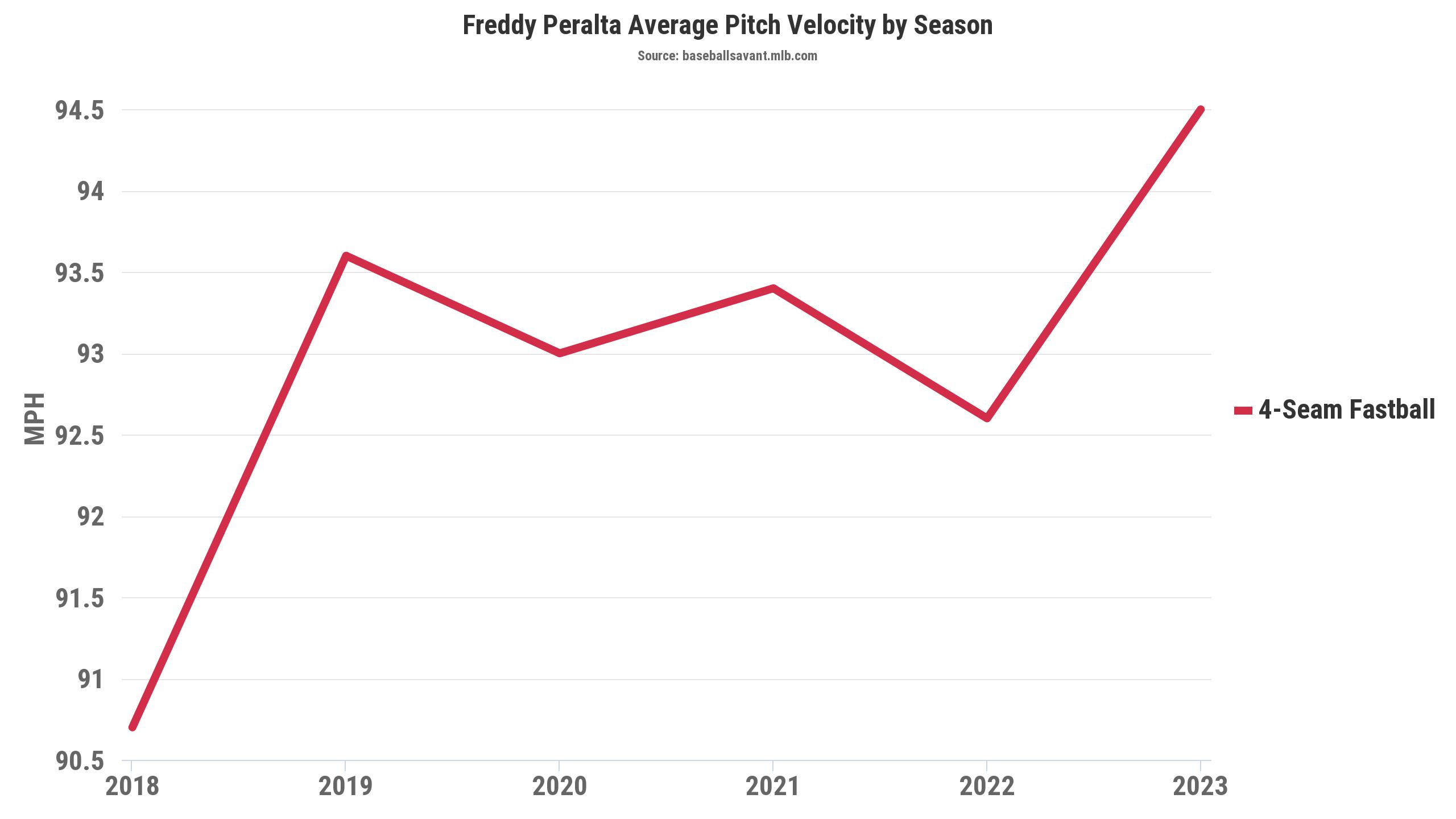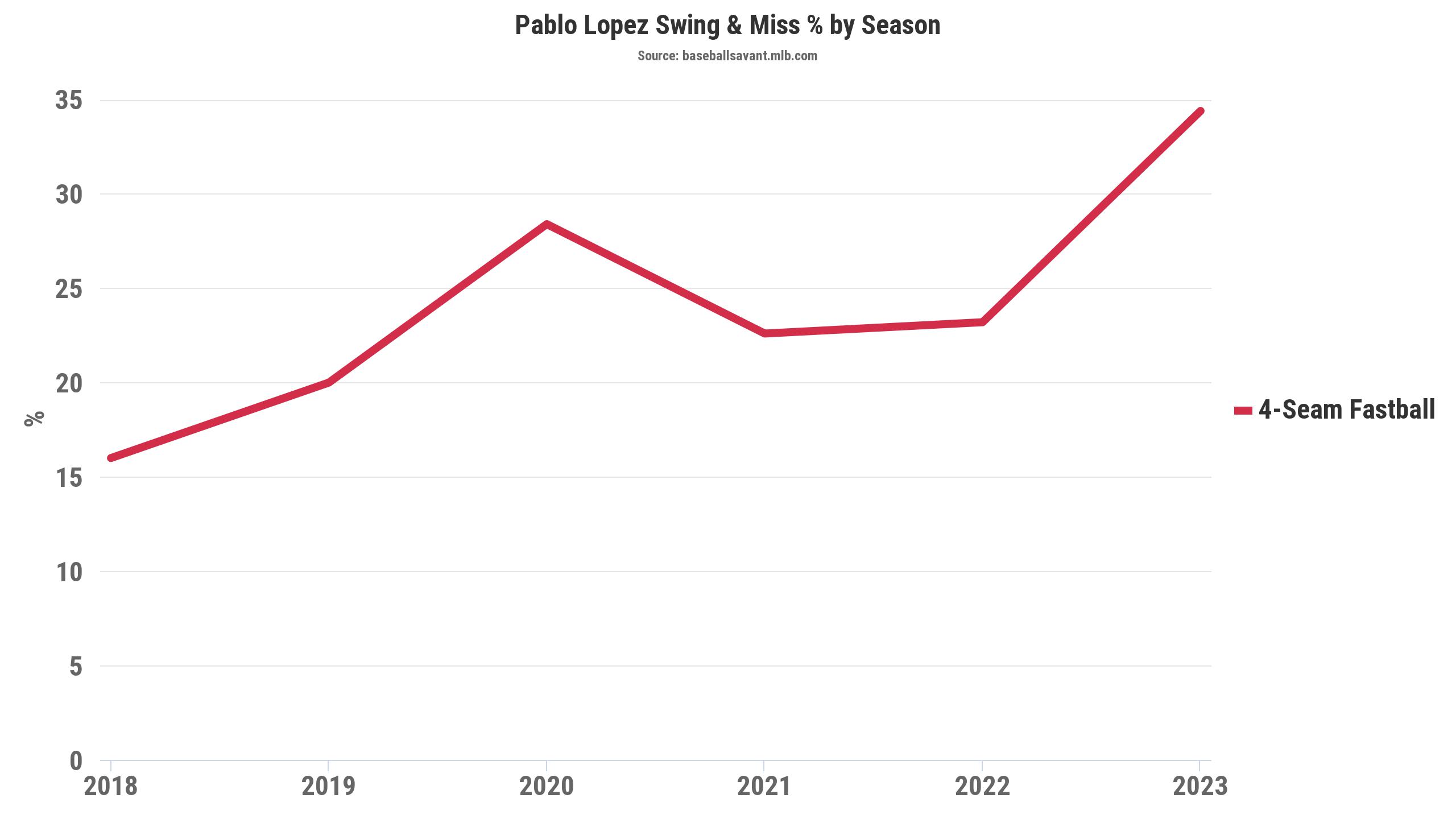Baseball is a game of constant adjustments. Every season, players tinker with their mechanics, rework their approaches, and change their mindsets to stay ahead of the competition. This is more necessary than voluntary for players at the highest level; a survival tactic, if you will.
Pitchers, in particular, are notorious tinkerers. The pitching landscape has been changing rapidly over the last few years with the introduction of more detailed tracking and movement data, prompting many pitchers to seek out the most advantageous movement profiles and attack angles to give them the edge over hitters.
Lucky for us, all of this data is tracked on a pitch-by-pitch basis, so we can tell pretty quickly which pitchers are making noticeable changes to their arsenals and what those changes are.
With that, I want to look into some starters who are adjusting their arsenals early on in the 2023 season, either by changing the shapes of their existing pitches or introducing new ones altogether. This might give us some interesting insight into the processes of players and teams as well as give us the inside edge on finding diamonds in the rough for fantasy purposes.
In one of my previous going deep pieces, I talked about how I liked Freddy Peralta as a slightly underrated starter during draft season thanks to some subtle arsenal adjustments he made toward the end of the 2022 season and a clean slate of health coming into this year. Over his first three starts of the 2023 season, it appears I might have actually been underselling how good he could be.
One of the primary driving forces behind his early performance has been his signature fastball, which has always been difficult to square up consistently for major league hitters but has added almost 2 full ticks of velocity compared to the 2022 version. Freddy has come out of the gate averaging 94.6 MPH on the heater, and the early returns have been solid.

The pitch still features a nearly identical movement profile to 2022, averaging about a 16″ vertical break and 9 inches of arm side run. The added velo has taken it from a 112.8 Stuff+ in 2022 to a 126 Stuff+ thus far in 2023. Retaining the unique shape of the fastball and adding about 2 MPH should serve Peralta well going forward this season, assuming he’s able to maintain this velocity bump.
The most drastic change Peralta’s arsenal has undergone, however, is the shape of the slider, his most prominent secondary offering. In 2021, Peralta featured a slider that closely resembled many of the sweepers we see overtaking the sport today. It had 14 inches of horizontal sweep at 80.5 MPH, both squarely in the range for the current classification of a sweeper.
Either due to injury or some attempted adjustments, Peralta’s 2022 slider slashed that glove-side sweep down to just eight inches. Consequently, the pitch registered a diminished swinging strike rate (20.7% to 14.2%) and reduced usage (26% to 18%), suggesting Peralta may have felt pressure to lean on his fastball too much throughout the 2022 season.
Early on in 2023, it looks like he’s trying to revert the slider back to its 2021 form. He’s added back over four inches of sweep and is throwing it about a tick harder, resulting in a Stuff+ surge from 94 to 112. You can see the difference pretty clearly between the 2022 and 2023 slider just by watching:

Aside from the primary four-seam/slider mix, Peralta has been fine-tuning the rest of his arsenal as well. He’s added a tick of velocity to his changeup and added some ride to it in order to improve its separation from the fastball, and his curveball has also added some vertical drop and velocity early in the season.
Early returns indicate Peralta is trying to turn the clock back to 2021 with his pitch shapes across the board while adding some velocity to most of his offerings. If this ends up being the case, it wouldn’t be surprising to see a full 2023 season with a similar level of success to his 33.6 K%, 2.81 ERA 2021 campaign.
When Pablo López was traded from the Marlins to the Twins this past winter, many were skeptical of Minnesota for giving up a reigning batting champion in Luis Arráez for a consensus mid-rotation starter and a lottery ticket prospect. Myself, I was actually skeptical about it from the Marlins’ perspective.
López had shown flashes of top-of-the-rotation stuff in the not-too-distant past and Arráez is a remarkably one-dimensional player who would likely be further pushed towards a strictly contact-oriented approach in the cavernous Marlins Park. I didn’t like it even as a 1-for-1 swap, so the fact that a decent prospect in Jose Salas was headed to Minnesota along with López just made me more apprehensive.
A couple of weeks into the 2023 season, the trade has actually worked out beautifully for both sides to this point.
Arráez is looking to repeat as batting champion, this time in the National League, hitting over .500 over the first 14 games of the season at the time of writing. López, meanwhile, has come out of the gate looking better than ever in a Twins uniform, and he has some notable arsenal adjustments to thank for that early success.
The first thing you’ll notice when looking through López’s 2023 arsenal is the advent of a new sweeper, which is getting 12.6 inches of horizontal movement at about 84 MPH through four starts and 26 innings.

He’s thrown this pitch 22% of the time to the tune of a 24.4% swinging strike rate, best among all starting pitchers and 2nd-best among all pitchers with at least 20 thrown in 2023. López’s sweeper also leads the world in CSW%, with opponents mustering just a .120 wOBA against it.
The sweeper is the main culprit behind López’s resurgence, but behind the scenes, he’s also added almost 2 MPH and an inch of ride to his fastball, tightened up his changeup/fastball separation by adding a tick of velocity and a couple of inches of drop to the changeup, and added some vertical break to his curveball to round out his suddenly lethal array of weapons.
This set of arsenal changes is leading to much better results for his fastball outside of the uptick in velocity, as the four-seamer has improved from an 11.3% swinging strike rate in 2022 to 17.5% this year. His 34.4 Whiff% is also a career-high on the pitch.

López currently ranks in the top 20 among starters in overall Stuff+ at 106. His sweeper ranks 11th in the sport at 123 and his fastball has improved from 99 to 107 Stuff+ over the last year. Not only do these changes look sustainable, the early results they are yielding look very real.
Assuming these changes stick around, López looks to be primed for a career year in 2023. He’s not in quite as friendly of a home environment for pitchers, but the introduction of an elite sweeper and some smart adjustments to the rest of his arsenal give him enough weapons to continue pitching like an ace in Minnesota.
And apparently, the Twins themselves agree, as they just handed him a 4-year, $73.5M extension that will keep him in Minnesota for the next few seasons.
When it comes to Rays starters making changes to their arsenals, Jeffrey Springs and Drew Rasmussen have grabbed most of the headlines by overhauling their respective breaking balls and featuring sweepers more prominently. The ace of the Tampa Bay staff, Shane McClanahan, has been quietly shifting around the movement profiles on his changeup and breaking balls in order to optimize his fastball.
Shane already featured one of the most effective split-changes in the league in 2022, and he’s been tinkering with it this year to even better results. The velocity on the pitch has remained constant, but some of its movement has shifted from the vertical to the horizontal axis. The pitch is now getting about a half-inch more arm-side run and 2 inches less vertical drop in 2023.

Both Stuff+ and in-game results like the new changeup better, as it has gone from a 106 to a 109 (6th-best among starters) with a 38.1 CSW% and a 29.8 SwStr% that represents the best mark among starting pitchers.
Shane is also tightening up his curveball this year, taking some movement off of both planes and throwing it about a tick harder than last year. I suspect the intent here is to shape it into a sort of mirror pitch to his split-change in order to get better separation and more chases out of the zone. It appears to be working thus far, as the curveball has gone from a 22.9% chase rate in 2022 to 26% in 2023.
Shane’s command may be suffering slightly as a result of these changes, as he’s walked 11 batters in his 23 innings this year. I attribute that mostly to spotty fastball command and spraying the four-seamer arm-side above the zone too often, but the new shapes on his secondaries may be exacerbating the issue.
Still, Shane has looked just as dominant this year as he did in the first half of 2022. These changes are relatively tame compared to some of the others we’ll see in this piece, but I think tinkering like this is just as interesting to look at as wholesale changes to an arsenal can be.
The Rays really had to rain on my parade here by putting up eight runs on Nick Lodolo a couple of days before publishing this piece, didn’t they? Well, regardless, he’s still making some interesting adjustments to his pitch mix this season.
Lodolo was a pretty sinker-heavy guy last year, splitting up his fastball usage at about 27% for the sinker and 32% for the four-seamer. This year, however, Lodolo is only throwing the sinker 5% of the time while the four-seamer has jumped up to 46% usage. The heavier emphasis on his four-seamer seems to be intentional, as the pitch has added over an inch of ride and is getting more whiffs than the 2022 version.
The most drastic change has come with his curveball, which is now getting two inches more horizontal sweep and is coming in about 2 MPH slower this year. It now has the 2nd-highest chase rate among curveballs thrown by starters this year and the 4th-highest swinging strike rate. Adding more glove-side break appears to be making the pitch tougher on righties than it already was in 2022.

Stuff+ actually isn’t a huge fan of this change, as it now grades Lodolo’s curveball a 95 compared to 105 in 2022. Still, the results have been better and Lodolo seems to be throwing it more, indicating a higher level of confidence with the pitch.
Lodolo’s changeup has also been the subject of some tinkering, as it now features over an inch more arm-side run at 87 MPH. The result has been a spike in SwStr% despite similar usage to 2022.
Lodolo seems to be de-emphasizing the sinker, adding more break on both sides of the horizontal plane, and throwing all his pitches from a slightly higher release point. The jury is currently out on whether these changes will be effective in the long term, but the early results are promising despite his most recent blowup outing.
This will probably be the most obscure arm I’ll talk about in this article, but the attention is well deserved. JP Sears has quietly reworked his arsenal into a workable state as a starter this year.
Notably traded from the Yankees to the Athletics in the Frankie Montas deal, Sears appeared to be destined for a role in the Oakland bullpen as a long reliever and swingman heading into this season. A few weeks in, however, Sears has already made three starts thanks in large part to the horrific state of the Athletics starting rotation.
In those three starts, we’ve seen some promising stuff under the hood despite some unassuming results. Sears has added almost two inches of ride on his fastball, giving it a nice Stuff+ boost from 82 to 100. This increased IVB, along with a slightly lower release height, has given Sears an exceptional vertical approach angle that should make his fastball much more difficult to square up as he throws it more.
Sears has also joined the sweeper party this year, throwing the pitch with 13.2 inches of sweep and 6.5 inches of drop at 80 MPH. The pitch has a below-average swinging strike rate but an above-average chase rate, resulting in a lot of weak contact that should turn into whiffs with more exposure.

This pitch has among the most horizontal sweep of any left-handed sweeper thrown by a starter and gives Sears access to another weapon on the horizontal plane to attack hitters with. Stuff+ is skeptical, giving it an 86 in its current state, so we’ll see if the pitch can evolve into a legit cornerstone of Sears’ arsenal.
By ditching the slider in favor of a sweeper and improving his fastball on all fronts, Sears all of a sudden looks like someone worth keeping an eye on in Oakland. I’m not telling you to rush out and pick him up in your leagues, but with his home ballpark and these interesting changes, keep tabs here.
I mean, come on. You just knew the Rays had something planned here when they shelled out $40M+ for Zach Eflin. With how diverse his arsenal already was coming over from Philadelphia, there was a seemingly infinite number of ways this could go. Four-seamer, cutter, sinker, curveball, slider, changeup, all of it was in play.
There’s going to be a lot to go over here, folks.
First and foremost, it looks like Eflin has all but ditched the four-seamer, throwing it just 2% of the time in 2023 after posting a 16% usage in 2022. It was never a particularly great fastball, registering 93 MPH on average with 14 inches of ride and a decent amount of arm-side run. Just for fun, though, he added a little under an inch of ride.
To compensate for the vacant space left by the four-seamer, Eflin is now throwing a more even mix of sinkers and cutters, with sinkers coming primarily against right-handed hitters and cutters coming against lefties. The sinker is featuring an inch more arm-side break with an additional 1.5 inches of drop, while the cutter has almost two inches more glove-side run. It’s pretty clear that the intent is to use these pitches as mirrors of each other, giving Eflin a weapon to pressure the inner half of the plate for both righties and lefties effectively.

It’s a smart plan that will likely result in a lot of weakly pulled ground balls for Eflin. Replacing the four-seamer with a fastball mix that leverages the horizontal plane opens up the opportunity to manipulate his breaking pitches, which of course you already know he did.
Eflin’s curveball has remained his primary breaking pitch this season, and it looks a lot better to this point. He’s added over two inches of depth and 1.3 inches of sweep to the pitch and is throwing it slightly harder. This is all good stuff that has yielded a better swinging-strike rate and CSW% in this small sample.
He also features the occasional slider, which is being thrown with significantly more lift and sweep this year. This makes me think he’s trying to incorporate some gyro slider/cutter interplay by tightening up his movement profiles, but who knows how deep this rabbit hole goes?
The real star of the show here is Eflin’s changeup, mostly because it’s just incredibly weird now. He’s throwing it over 2 MPH softer, added 1.5 inches of ride and over three inches of arm-side run to it, and heightened his release slightly. This is exceptionally strange, as most changeups have a much tighter IVB separation from the fastball. It’s almost like he’s throwing a changeup with the intent of a four-seamer instead of actually just throwing a four-seamer. I don’t fully understand it, either.

It should be noted that the Rays have a history of working with weird changeups, but this is just another level of strange. My best guess is that he’s changed his seam orientation on the changeup to give it some unique perceived movement that interacts with his fastballs to create deception. Regardless, it’s incredibly cool and I’m excited to see how the pitch evolves over his career with the Rays.
I could definitely talk about pitch shapes all day. The interplay between pitches and why certain guys are making changes is a never-ending font of knowledge and insight into the art of pitching. There are so many more guys I could talk about to some length.
Ryne Nelson adopting the gyro slider/sweeper approach, Taj Bradley debuting with one of the best fastballs in the sport, Kris Bubic setting baseball Twitter on fire after adding fastball velo and improving his slider, these are all things I could talk about for hours upon hours.
It’s important not to get too tied up in early season changes because they have to be maintained in order to be consequential long-term, but I encourage you to look into some pitch data after your favorite starter takes the mound and see if there’s anything you can learn by watching how his arsenal evolves on a game-by-game and even inning-by-inning basis. It adds a whole new level of depth to the sport that you may become captivated with as much as I have.

